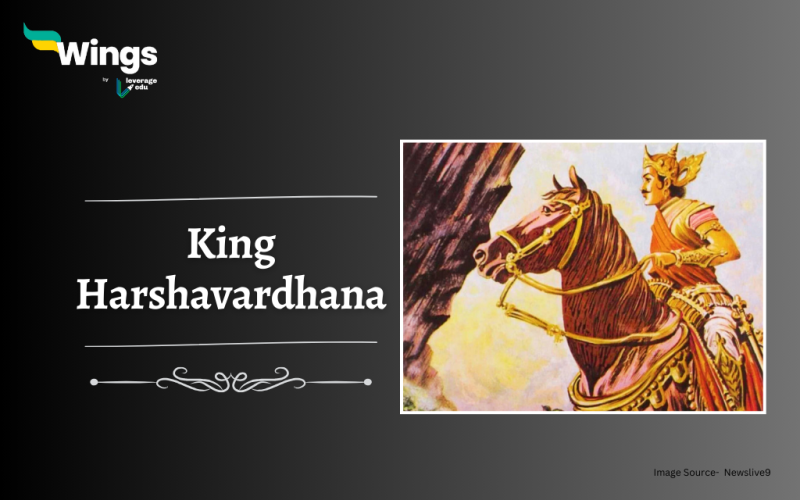King Harshvardhana, or King Harsha, was the emperor of Kannauj and ruled North India from 606 to 647 CE. He was the son of Prabhakarvardhana, the founder of the Pushyabhuti Dynasty or the Vardhana Dynasty. His reforms and policies were generous and were always aimed at boosting the peace and prosperity of his people. Read this blog to learn more about “King Harshavardhan.”
Table of Contents
| Overview About King Harshavardhana | |
| Reign | 606 AD – 647 AD |
| Dynasty | Vardhana (Pushyabhuti) |
| Predecessor | Rajyavardhana (brother) |
| Capital | Kannauj |
| Religion | Hindu (converted to Mahayana Buddhism later) |
| Military Campaigns | Defeated Gauda King Shashanka, Chalukya King Pulakeshin II |
| Empire | Stretched from Gujarat to Assam (significant influence) |
| Direct Control | Likely modern Uttar Pradesh, parts of Punjab and Rajasthan |
| Administration | Relied on centralized governance with benevolent policies |
| Legacy | Patron of arts, literature, and learning (composed plays and poetry) |
| Religious Tolerance | Promoted religious harmony, supported Hinduism, Buddhism, and Jainism |
| Historical Significance | An important figure in Indian history. |

Early Life Of King Harshavardhana
Harshavardhana was born in Thanesar in 590 AD, which is presently a part of Haryana.
- His father was King Prabhakara, the founder of the Pushyabhuti Dynasty.
- In school, Harshavardhana studied many things, like Vedas, philosophy, and astrology.
- Early interests in the arts and literature also became significant to him as a king.
- His father, Prabhakara Vardhana, was the king of Thanesar and famous for winning many battles.
- Queen Yasomati, his mother, was a devout Buddhist, and Harshavardhan was greatly impacted by her views.
- Rajya Vardhana, his elder brother, assisted their father in ruling the kingdom and was also a skilled fighter.
Also read: Amartya Sen: Life, Contributions & More!
King Harshavardhana’s Empire
Harsha, after taking over Kannauj, united two kingdoms- Thanesar and Kannauj.
- After the fall of the kingdom of the Guptas, the northern part of the country was divided into various kingdoms, and Harsha, under his rule, united many of them.
- However, Harsha’s plans to conquer areas to the south were derailed in 618–619 A.D. when he lost to Pulakesin II, the Chalukya king.
- Hiuen Tsang travelled to India while Harsha was emperor. He has provided an extremely positive description of King Harsha and his empire.
- His reforms included a good tax structure, 1/4th of the total taxes that were collected were used for charity and cultural activities.
Also Read: Who Is Meghnad Saha?
King Harshavardhana’s Death
King Harshavardhana died when he was 57.
- There was no son or daughter born to Harshavardhan to succeed him as king.
- His sister’s son became the new king, his name was Arjuna Vardhana.
- Even after his death, his contributions to education, culture, and religion remained significant.
FAQs
King Harshavardhana ruled North India from 606 to 647 CE as part of the Vardhana Dynasty, known for his benevolent governance and patronage of arts.
He united Northern India, promoted religious harmony, and supported cultural activities, leaving a significant legacy in Indian history.
He was a prolific writer and patron of literature and the arts which contributed largely to the Indian Culture.
Relevant Blogs
This was all about King Harshavardhana. If you want to know more about other Famous Personalities then visit our General Knowledge page!
 One app for all your study abroad needs
One app for all your study abroad needs













